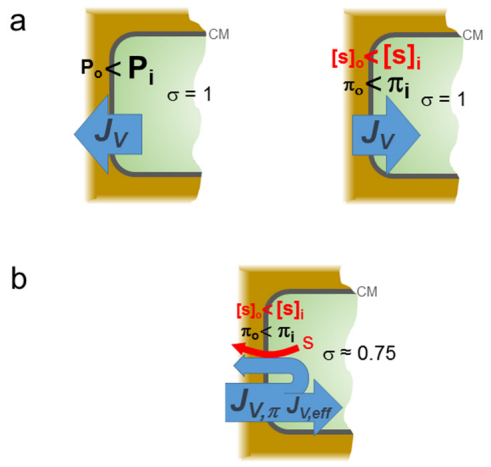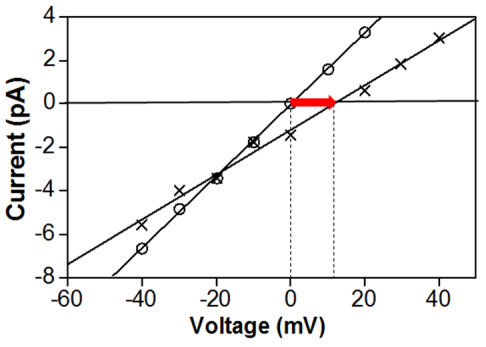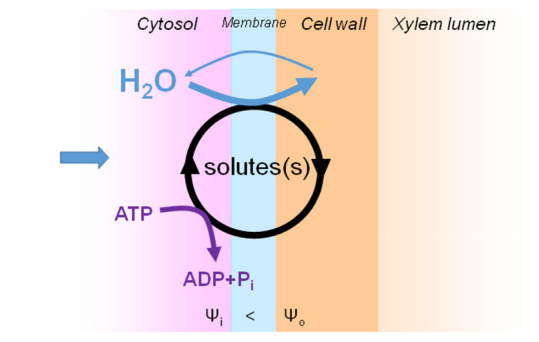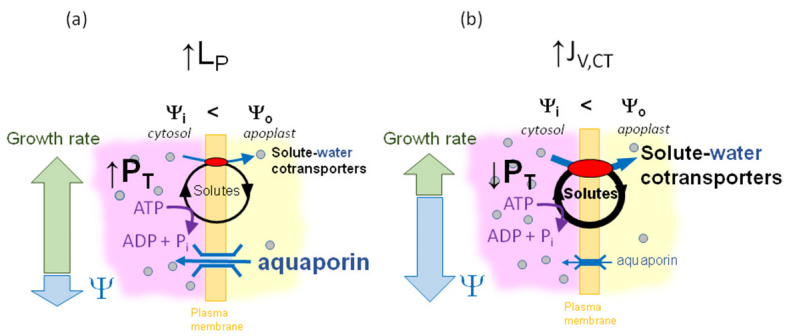Current concepts of plant membrane transport are based on the assumption that water and solutes move across membranes via separate pathways. According to this view, coupling between the fluxes is more or less exclusively constituted via the osmotic force that solutes exert on water transport. This view is questioned here, and experimental evidence for a cotransport of water and solutes is reviewed. The overview starts with ion channels that provide pathways for both ion and water transport, as exemplified for maxi K+ channels from cytoplasmic droplets of Chara corallina. Aquaporins are usually considered to be selective for water (just allowing for slippage of some other small, neutral molecules). Recently, however, a “dual function” aquaporin has been characterized from Arabidopsis thaliana (AtPIP2.1) that translocates water and at the same time conducts cations, preferentially Na+. By analogy with mammalian physiology, other candidates for solute-water flux coupling are cation-chloride cotransporters of the CCC type, and transporters of sugars and amino acids. The last part is dedicated to possible physiological functions that could rely on solute-water cotransport. Among these are the generation of root pressure, refilling of embolized xylem vessels, fast turgor-driven movements of leaves, cell elongation (growth), osmoregulation and adjustment of buoyancy in marine algae. This review will hopefully initiate further research in the field.
1.
Introduction
Schizophrenia is a complex psychiatric disorder with a prevalence rate of about 1 in 222 people (0.45%) among adults [1]. It affects people all over the world because of its long-term course, severe personality changes, and neurocognitive deficit such as working memory, attention and executive function that reduces the quality of life and causes a high percentage of patient disability [2],[3]. A neurocognitive deficit occurs in the early stage of schizophrenia and usually persists at all stages of the disorder [4]. It is recognised as a separate domain alongside positive and negative problems in several schizophrenia concepts, and it is an essential predictor of the disease's unfavourable prognosis and the development of persistent social dysfunction [5].
Multiple lines of evidence link altered neurotransmitter systems and brain connections with clinical observations of cognitive deficits and negative symptoms to disrupted neuroplasticity as the aetiology of schizophrenia [6]–[10]. One of the processes that are known to mediate neuroplasticity in the central nervous system is changes in neurotrophic factor activity [11],[12]. Neurotrophins such as brain-derived neurotrophic factor (BDNF), nerve growth factor (NGF) and glial cell line-derived neurotrophic factor (GDNF) are neuronal activity regulators involved in the development and maintenance of the mature nervous system, and as such, they may also contribute to the pathophysiology of schizophrenia [13].
Schizophrenia has become a rather wide discipline with its various research areas, which increases the number of studies every day and is one of the most researched topics in psychiatry. Earlier bibliometric studies mapped the author collaborations in schizophrenia [14] and the global scientific outputs of schizophrenia publications [15]. The former study involved 58,107 records from 2003 to 2012, downloaded from the Science Citation Index Expanded (SCI-Expanded) via the Web of Science. Based on their hierarchical clustering analysis, genetic research in schizophrenia was the main collaborative field. The latter study analysed 103,992 records also from the Web of Science database between 1975 and 2020. The authors demonstrated that some of the trend keywords that have been used in recent years include BDNF. BDNF is one of the most studied neurotrophins and is produced at the pre- and post-synaptic neurons [16]. It influences synaptic plasticity, causing significant changes in cognitive functioning, learning, and memory [17],[18]. It is also necessary for the development and maintenance of dopaminergic, GABAergic, cholinergic, and serotonergic neurons [19]. Variations in BDNF may cause changes in the brains of schizophrenia patients, such as a reduction in frontal grey matter volume and an increase in lateral ventricles and sulcal cerebrospinal fluid volume [20]. Additionally, BDNF has been investigated as a possible biomarker in cognition [21],[22] diagnosis and evaluation of schizophrenia [23]. To the best of our knowledge, this is the first article to carry out a bibliometric analysis of BDNF and schizophrenia publications. A few bibliometric analytic methodologies were used to address the following research issues.
-
What are the main subjects and themes of the research on BDNF and schizophrenia?
-
What are the important strong research areas in the field of BDNF and schizophrenia?
-
What are the research trends and changes in the authors' knowledge network related to recent literature on schizophrenia and BDNF?
2.
Materials and methods
The data were retrieved on 27th April 2022 from the Scopus database. A search of the relevant literature was carried out using the Scopus database because this database includes a larger number of publications and has more citations [24],[25]. We believed that there is sufficient information available to provide a sketch of the scientific landscape, research hotspots, and other pertinent details. The following search query in the article title was used: (TITLE(schizophrenia) AND TITLE (“brain derived neurotrophic factor” OR “brain-derived neurotrophic factor” OR bdnf)). Documents other than the English language (n = 9), retracted (n = 1) and the erratum (n = 13) documents were excluded (Figure 1).
A total of 335 documents were extracted from the Scopus database in Microsoft Excel (.xls), Research Information Systems (.ris) and Comma-Separated Values (.csv) format. The data in .ris and .csv format were analysed using Harzing's Publish or Perish [27] and VOSviewer version 1.6.17 [28] for descriptive and network analysis, respectively.
3.
Results
3.1. Publication trends
Figure 2 depicts the annual trends in the number of publications. The publications barely reached two digits in 2005 and show an overall upward trend which peaks in 2021. The trend line shows that the number of publications increases polynomially (R2 = 0.7365).
3.2. Most productive authors
Most productive authors in that discipline are individual researchers who have made significant contributions to the growth and evolution of a research field. In BDNF and schizophrenia research, Zhang XY is ranked topmost with 22 publications and 938 citations, followed by Chen DC (14 publications, 736 citations), Tan YL (10 publications, 317 citations), Soares JC (10 publications, 277 citations), and Kosten TR (9 publications, 601citations) as shown in Table 1. The most productive authors are mostly from China and two from the USA and they co-authored some of the studies.
3.3. Most influential works
Table 2 listed the most cited publications on BDNF and schizophrenia in terms of the total number of citations. The journal Molecular Psychiatry published half of the papers listed in Table 2. Angelucci et al. [17] published in Molecular Psychiatry in 2005 was the topmost cited, with 445 citations. The second topmost cited article was an original article involving 57 post-mortem brains of patients with schizophrenia that was also published in Molecular Psychiatry in 2003 [29]. The third topmost cited article was a meta-analysis of 39 case-control studies encompassing psychiatric phenotypes: eating disorders, substance-related disorders, mood disorders, and schizophrenia, among others. This article was published in Biological Psychiatry in 2007 [30].
3.4. Keyword co-occurrence network
In this study, VOSviewer was used to generate the keyword co-occurrence map. A total of 457 keywords were collected from our collection of 335 BDNF and schizophrenia publications. Only keywords that appeared at least three times were selected for keyword analysis. This criterion was met by 79 keywords out of 457. Our analysis indicates that the keyword network has four distinct clusters as shown in Figure 3: cluster one (red, 26 keywords), cluster two (green, 21 keywords), cluster three (blue, 21 keywords) and cluster four (yellow, 11 keywords).
3.5. Co-citation network of the most influential works
In this study, VOSviewer was used to generate the co-citation network map. The data was evaluated using the fractional counting approach with 10 as a minimum number of citations of a cited reference to create a co-citation network. The minimum cluster size was set at five. This criterion was met by 39 cited references out of 14144. The analysis resulted in a three-cluster network (Figure 4), the top 10 of which are listed in Table 3, while Table 4 summarizes BDNF in the schizophrenia co-citation network. The yellow cluster in the co-occurrence network analysis (Figure 3) correlated to the red cluster, which was associated with BDNF as a neurobiological marker in treatment monitoring (Figure 4). While the green and blue clusters exhibited a correlation with the blue and green clusters, respectively, these clusters were connected to the brain's BDNF distribution related to memory function and the function of BDNF polymorphism in the pathogenesis/risk of schizophrenia. The red cluster in the co-occurrence network analysis (Figure 3) was dispersed throughout all three clusters in Figure 4.
3.6. Bibliographical coupling network (document based)—2018–2022
In this study, VOSviewer was used to generate the bibliographical coupling network map. The BDNF and schizophrenia publications from 2018 to 2022 were evaluated by bibliographic coupling using the full counting approach. A document with five as a minimum number of citations was selected to create a bibliographic coupling network. This criterion was met by 38 documents out of 345. Bibliographic coupling resulted in a five-cluster network (Figure 5), the details of which are listed in Table 5. The network's total link strength is 2570, meaning, the 37 document-based bibliographic networks appeared 2570 times jointly. There are a total of five clusters. The first cluster (red) shows the highest degree of coherence within the cluster while the fifth cluster (purple) shows the lowest degree of coherence within the cluster.
4.
Discussion
The BDNF and schizophrenia publications show an overall upward trend that peaks in 2021. The first article on the topic of BDNF in schizophrenia was published in the American Journal of Medical Genetics in 1997. This was the first scientific work indexed in the Scopus database to deal with the BDNF polymorphism as the possible candidate gene for schizophrenia [92]. This study was conducted on 60 unrelated Japanese schizophrenic patients and reported no evidence for the association between polymorphism and schizophrenia. Other studies included the Japanese population [93], the relationship between brain morphology and BDNF [94], SNPs within BDNF [95], and the effects of aripiprazole on BDNF [96]. The study also suggested further studies to be conducted on a larger number of subjects including other ethnicities. Case-control studies were later conducted on 130 French Caucasian schizophrenic patients and healthy volunteers [97] and 265 familial schizophrenic and healthy subjects in Irish families [98]. Both studies found no significant differences in allele frequencies or genotype distribution between patients and controls [97],[98]. Some of the later studies were also conducted in different populations such as Scottish [34], Dutch [99], Chinese [100]–[106], Asian [107], Russian [108], Egyptian [109],[110], Polish [111]–[113], Malay [114], and Turkish [115],[116]. These highlight the diversity in genetic research and the importance of studying BDNF and its related receptor genes in different populations.
The most prolific authors in a field can assist to identify scholars who have made significant contributions to the field's growth and progress. Most of the prolific authors are mostly from China and two are from the USA and they co-authored some of the studies. Their studies addressed a variety of themes which were related to BDNF and smoking [117]–[119], antipsychotic drugs [120],[121], symptoms of schizophrenia [121],[122], risk of schizophrenia [103], and cognition [22],[57],[79].
Most influential works are the most cited publications that have shaped the knowledge structure of a domain in that discipline. A review article by Angelucci et al. [17] published in Molecular Psychiatry in 2005 was the topmost cited, with a total of 445 citations. This review article described altered BDNF in schizophrenia, depression and animal models, as well as the effects of antipsychotic and antidepressive treatments on the expression of BDNF. The hypothesis was related to the malfunction of neurotrophic factors, which include BDNF, a mediator involved in neuronal survival and plasticity of dopaminergic, cholinergic, and serotonergic neurons in the central nervous system [17]. One of the animal models displaying structural brain deficits and supports the hypothesis that BDNF is implicated in the pathophysiology of schizophrenia was obtained by administering a single injection of methylazoxymethanol acetate (MAM) [123]. The second topmost cited article was an original article that was also published in Molecular Psychiatry in 2003. The study involved 57 post-mortem brains of patients with schizophrenia. They found a reduction in BDNF production and availability in the dorsolateral prefrontal cortex (DLPFC) of schizophrenics, and suggest that intrinsic cortical neurons, afferent neurons, and target neurons may receive less trophic support [29]. The third topmost cited article was published in Biological Psychiatry in 2007. The article was a meta-analysis of 39 case-control studies encompassing psychiatric phenotypes: eating disorders, substance-related disorders, mood disorders, and schizophrenia, among others. The study confirms the association of Val66Met with substance-related disorders, eating disorders, and schizophrenia [30]. The original and review articles about BDNF and its TrkB receptor [32],[33], BDNF polymorphism [124] and its role as cognitive markers [22],[36], and therapeutic response in patients with schizophrenia [37] make up the remaining top cited documents.
Keyword co-occurrence networks aid in the identification of relevant keywords used in publications within a knowledge domain and provide information on the domain's core research themes [125]. Our analysis resulted in four distinct clusters. The red cluster is the largest cluster with common keywords such as BDNF, neurotrophic factor, cognition, neuroplasticity, neurodevelopmental, and first-episode schizophrenia. These keywords indicate that the red cluster has publications that focus on the BDNF role related to the pathogenesis of schizophrenia. The research focused on the neurobiology of schizophrenia has emphasized the relevance of neurodevelopmental and neurotoxicity-related elements in the pathogenesis of this disease as reflected by the relevant keywords such as neuroplasticity, neurodevelopmental, and neuroprotection. Another important inference in this cluster is related to biomarkers for schizophrenia that include peripheral (BDNF/neurotrophic factor, matrix metallopeptidase 9 (MMP-9), cytokine, oxidative stress) and neuroimaging (magnetic resonance imaging (MRI), cortical thickness) biomarkers.
The green (second) and blue (third) clusters are the second largest cluster, each with 21 keywords. Association, polymorphism, genetic, psychosis, age of onset, genetic polymorphism and smoking are the common keywords in the green cluster. These keywords indicate that the green cluster has publications that focus on BDNF polymorphism associated with smoking/nicotine in schizophrenia as well as functional polymorphisms of other genes such as dopamine, drd3 and COMT. While the common keywords in the blue cluster include schizophrenia, antipsychotic, cognitive function, cognitive deficit, depression, risperidone, olanzapine, and positive and negative syndrome scale (PANSS). This cluster has publications that focus on the role of BDNF in monitoring the effects of antipsychotics on PANSS and cognition.
The yellow cluster is the smallest cluster and the main keywords are BDNF val66met, meta-analysis, bipolar disorders, biomarker, single nucleotide polymorphism (SNP), DNA methylation, prefrontal, and epigenetic. These keywords indicate that the yellow cluster has publications that focus on the role of BDNF polymorphism as a biomarker in the pathogenesis of schizophrenia and bipolar disorders. Another important inference from this analysis is that this cluster employed meta-analysis while studying the BDNF polymorphism as a biomarker.
Co-citation networks, which are commonly utilised in bibliometric network analysis, concentrate on the interactions or linkages between two publications [126]. When two papers are cited in a third paper, the former is said to as ‘co-cited.’ As more publications cite both of them, the co-citation relationship between them becomes stronger [127] and indicates strong study topics in a knowledge domain [128]. The first cluster (red) consists of 15 documents and six of which are listed as the top 10 with the highest total link strength (TLS) [31],[40],[42]–[45]. This cluster focuses on BDNF as a neurobiological marker and was used for diagnosis and treatment monitoring [31],[42],[45]–[50]. In terms of the time frame, this cluster has the widest range, comprises of documents published from 1987 to 2012.
Cluster 2 (green) has the same size as cluster 1 (red) and three documents are listed in the top 10 with the highest TLS [29],[39],[41]. This cluster consists of 15 documents that discuss the distribution of BDNF in the brain and its role in memory [29],[32],[39],[41],[51]–[54]. In terms of the publication date, this cluster includes works from 1991 to 2003. Finally, cluster 3 (blue) has the lowest number of documents and only one of the documents is listed in the top 10 with the highest TLS [38]. This cluster discusses mainly the role of BDNF polymorphism in the pathogenesis and risk of schizophrenia [20],[34],[38],[55]. It includes documents from 2001 to 2005.
Another widely used method for analysing and visualising knowledge networks in a topic is bibliographic coupling [129]. Two publications are bibliographically connected if they both quote the same third publication, i.e., they have the same reference list, with a higher commonality of publication suggesting a stronger coupling [129],[130]. It is a potential method of examining recent trends and changes in an author's knowledge network over time [128]. There are a total of five clusters. The first cluster shows the highest degree of coherence within the cluster. In the cluster (in red in Fig. 4), “Sex difference in the association of body mass index and BDNF levels in Chinese patients with chronic schizophrenia”, the most important article was the one by Yang et al. [56], which focused on the needs to consider sex when assessing the relationship between BDNF and metabolic syndromes in schizophrenia. Atake et al. [63] commented on the impact of ageing, psychotic symptoms, medication, and brain-derived neurotrophic factor on cognitive impairment in Japanese chronic schizophrenia patients. Both articles discussed the changes in BDNF levels due to different factors in two different ethics i.e. Chinese and Japanese schizophrenia patients. Weickert et al. [66] and Skibinska et al. [62] had the highest total link strength in researching the increased plasma BDNF in females with schizophrenia, and the association between val66met functional polymorphism and serum BDNF in schizophrenia and depression, respectively.
In the second cluster (in green in Fig. 4), the most important article was “Dysfunction in brain-derived neurotrophic factor signalling pathway and susceptibility to schizophrenia, Parkinson's and Alzheimer's diseases” by Mohammadi et al. [67]. The review paper highlighted the BDNF signalling pathway dysfunction in various brain diseases. The BDNF dysfunctions were also reported in schizophrenia and schizoaffective disorder by other studies in the same cluster [72]–[75].
In the third cluster (in blue in Fig. 4), “Cognitive impairments and low BDNF serum levels in first-episode drug-naive patients with schizophrenia”, was the most important article by Man et al. [77]. In both patients and healthy controls, no significant link was identified between BDNF and neuropsychological score. The study findings imply that excessive cognitive deficits are prevalent in the early stages of schizophrenia and low BDNF levels may have a role in the aetiology of schizophrenia, although not necessarily in cognitive problems. Other articles in the same cluster also reported the role of BDNF in the cognitive function of schizophrenia patients [68],[78],[79].
In the fourth cluster (in yellow in Fig. 4), three of the articles focused on the role of BDNF in the cognitive function of schizophrenia patients [80],[82],[84] as in the third cluster and had the highest total link strength. Two of the articles were related to ketamine-induced schizophrenia in animal models [84],[86]. While the fifth cluster (in purple in Fig. 4) is the smallest and exhibits the lowest degree of coherence within the cluster. The articles in this cluster had high total link strength except for the article by Hou et al. [91]. The article by Hou is related to the regulation of BDNF production by microRNAs (miRNAs).
5.
Conclusions
Research on schizophrenia and BDNF has advanced significantly, particularly among experts connected to China and the USA. The main themes and strong research areas of BDNF in schizophrenia include its role as a neurobiological marker (pathogenesis, treatment monitoring, and risk factors), and cognition in schizophrenia. Recent years have seen an increase in interest in research on pertinent topics, such as factors that alter BDNF levels or are linked to BDNF dysfunction in schizophrenia, cognition in schizophrenia, and animal models of the disease. Future studies should look into the novel potential roles of BDNF in schizophrenia including regulation of inflammation, modulation of mitochondria function, epigenetic regulation, and regulation of neural oscillations.










 DownLoad:
DownLoad:











